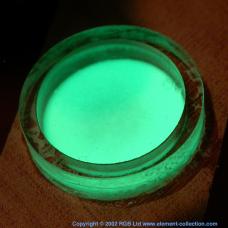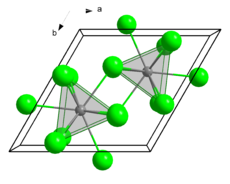 Glowing powder mixture of promethium(III) chloride and zinc sulfide
| |
 Crystal structure
| |
| Names | |
|---|---|
| Other names
Promethium chloride; Promethium trichloride
| |
| Identifiers | |
3D model (JSmol)
|
|
| ChemSpider | |
| ECHA InfoCard | 100.034.004 |
| EC Number |
|
PubChem CID
|
|
| |
| |
| Properties | |
| Cl3Pm | |
| Molar mass | 251 g·mol−1 |
| Density | 4.19 g/cm3 (calc., XRD)[1] |
| Melting point | 655 °C (1,211 °F; 928 K)[2] |
| Structure | |
| Trigonal, hP8 | |
| P63/m, No. 176[1] | |
| Related compounds | |
Other anions
|
Promethium(III) oxide |
Other cations
|
Neodymium(III) chloride, Samarium(III) chloride |
Except where otherwise noted, data are given for materials in their standard state (at 25 °C [77 °F], 100 kPa).
| |
Promethium(III) chloride is a chemical compound of promethium and chlorine with the formula PmCl3. It is an ionic, water soluble, crystalline salt that glows in the dark with a pale blue or green light due to promethium's intense radioactivity.